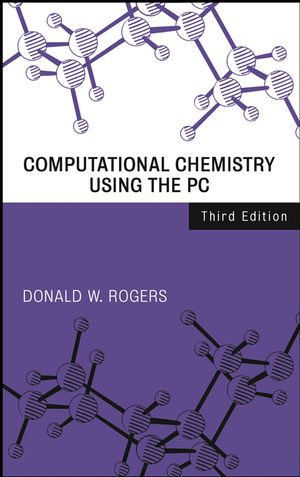Computational Chemistry Using the PC, 3rd EditionISBN: 978-0-471-42800-8
Hardcover
349 pages
October 2003
 This is a Print-on-Demand title. It will be printed specifically to fill your order. Please allow an additional 10-15 days delivery time. The book is not returnable.
|
||||||
Preface to the Second Edition.
Preface to the First Edition.
Chapter 1. Iterative Methods.
Iterative Methods.
An Iterative Algorithm.
Blackbody Radiation.
Radiation Density.
Wien’s Law.
The Planck Radiation Law.
COMPUTER PROJECT 1-1: Wien’s Law.
COMPUTER PROJECT 1-2: Roots of the Secular Determinant.
The Newton–Raphson Method.
Problems.
Numerical Integration.
Simpson’s Rule.
Efficiency and Machine Considerations.
Elements of Single-Variable Statistics.
The Gaussian Distribution.
COMPUTER PROJECT 1-3: Medical Statistics.
Molecular Speeds.
COMPUTER PROJECT 1-4: Maxwell–Boltzmann Distribution Laws.
COMPUTER PROJECT 1-5: Elementary Quantum Mechanics.
COMPUTER PROJECT 1-6: Numerical Integration of Experimental Data Sets.
Problems.
Chapter 2. Applications of Matrix Algebra.
Matrix Addition.
Matrix Multiplication.
Division of Matrices.
Powers and Roots of Matrices.
Matrix Polynomials.
The Least Equation.
Importance of Rank.
Importance of the Least Equation.
Special Matrices.
The Transformation Matrix.
Complex Matrices.
What’s Going On Here?
Problems.
Linear Nonhomogeneous Simultaneous Equations.
Algorithms.
Matrix Inversion and Diagonalization.
COMPUTER PROJECT 2-1: Simultaneous Spectrophotometric Analysis.
COMPUTER PROJECT 2-2 j Gauss–Seidel Iteration: Mass Spectroscopy.
COMPUTER PROJECT 2-3 j Bond Enthalpies of Hydrocarbons.
Problems.
Chapter 3. Curve Fitting.
Information Loss.
The Method of Least Squares.
Least Squares Minimization.
Linear Functions Passing Through the Origin.
Linear Functions Not Passing Through the Origin.
Quadratic Functions.
Polynomials of Higher Degree.
Statistical Criteria for Curve Fitting.
Reliability of Fitted Parameters.
COMPUTER PROJECT 3-1: Linear Curve Fitting: KF Solvation.
COMPUTER PROJECT 3-2: The Boltzmann Constant.
COMPUTER PROJECT 3-3: The Ionization Energy of Hydrogen.
Reliability of Fitted Polynomial Parameters.
COMPUTER PROJECT 3-4 j The Partial Molal Volume of ZnCl<sub>2</sub>.
Problems.
Multivariate Least Squares Analysis.
Error Analysis.
COMPUTER PROJECT 3-5: Calibration Surfaces Not Passing Through the Origin.
COMPUTER PROJECT 3-6: Bond Energies of Hydrocarbons.
COMPUTER PROJECT 3-7: Expanding the Basis Set.
Problems.
Chapter 4. Molecular Mechanics: Basic Theory.
The Harmonic Oscillator.
The Two-Mass Problem.
Polyatomic Molecules.
Molecular Mechanics.
Ethylene: A Trial Run.
The Geo File.
The Output File.
TINKER.
COMPUTER PROJECT 4-1: The Geometry of Small Molecules.
The GUI Interface.
Parameterization.
The Energy Equation.
Sums in the Energy Equation: Modes of Motion.
COMPUTER PROJECT 4-2: The MM3 Parameter Set.
COMPUTER PROJECT 4-3: The Butane Conformational Mix.
Cross Terms.
Problems.
Chapter 5. Molecular Mechanics II: Applications.
Coupling.
Normal Coordinates.
Normal Modes of Motion.
An Introduction to Matrix Formalism for Two Masses.
The Hessian Matrix.
Why So Much Fuss About Coupling?
The Enthalpy of Formation.
Enthalpy of Reaction.
COMPUTER PROJECT 5-1: The Enthalpy of Isomerization of cis- and trans-2-Butene.
Enthalpy of Reaction at Temperatures ≠ 298 K.
Population Energy Increments.
Torsional Modes of Motion.
COMPUTER PROJECT 5-2: The Heat of Hydrogenation of Ethylene.
Pi Electron Calculations.
COMPUTER PROJECT 5-3: The Resonance Energy of Benzene.
Strain Energy.
False Minima.
Dihedral Driver.
Full Statistical Method.
Entropy and Heat Capacity.
Free Energy and Equilibrium.
COMPUTER PROJECT 5-4: More Complicated Systems.
Problems.
Chapter 6. Huckel Molecular Orbital Theory I: Eigenvalues.
Exact Solutions of the Schroedinger Equation.
Approximate Solutions.
The Huckel Method.
The Expectation Value of the Energy: The Variational Method.
COMPUTER PROJECT 6-1 j Another Variational Treatment of the Hydrogen Atom.
Huckel Theory and the LCAO Approximation.
Homogeneous Simultaneous Equations.
The Secular Matrix.
Finding Eigenvalues by Diagonalization.
Rotation Matrices.
Generalization.
The Jacobi Method.
Programs QMOBAS and TMOBAS.
COMPUTER PROJECT 6-2: Energy Levels (Eigenvalues).
COMPUTER PROJECT 6-3: Huckel MO Calculations of Spectroscopic Transitions.
Problems.
Chapter 7. Huckel Molecular Orbital Theory II: Eigenvectors.
Recapitulation and Generalization.
The Matrix as Operator.
The Huckel Coefficient Matrix.
Chemical Application: Charge Density.
Chemical Application: Dipole Moments.
Chemical Application: Bond Orders.
Chemical Application: Delocalization Energy.
Chemical Application: The Free Valency Index.
Chemical Application: Resonance (Stabilization) Energies.
LIBRARY PROJECT 7-1: The History of Resonance and Aromaticity.
Extended Huckel Theory—Wheland’s Method.
Extended Huckel Theory—Hoffman’s EHT Method.
The Programs.
COMPUTER PROJECT 7-1: Larger Molecules: Calculations using SHMO.
COMPUTER PROJECT 7-2: Dipole Moments.
COMPUTER PROJECT 7-3: Conservation of Orbital Symmetry.
COMPUTER PROJECT 7-4: Pyridine.
Problems.
Chapter 8. Self-Consistent Fields.
Beyond Huckel Theory.
Elements of the Secular Matrix.
The Helium Atom.
A Self-Consistent Field Variational Calculation of IP for the Helium Atom.
COMPUTER PROJECT 8-1: The SCF Energies of First Row Atoms and Ions.
COMPUTER PROJECT 8-2: A High-Level ab initio Calculation of SCF First IPs of the First Row Atoms.
The STO-<sub>x</sub>G Basis Set.
The Hydrogen Atom: An STO-1G ‘‘Basis Set’’.
Semiempirical Methods.
PPP Self-Consistent Field Calculations.
The PPP-SCF Method.
Ethylene.
Spinorbitals, Slater Determinants, and Configuration Interaction.
The Programs.
COMPUTER PROJECT 8-3: SCF Calculations of Ultraviolet Spectral Peaks.
COMPUTER PROJECT 8-4: SCF Dipole Moments.
Problems.
Chapter 9. Semiempirical Calculations on Larger Molecules.
The Hartree Equation.
Exchange Symmetry.
Electron Spin.
Slater Determinants.
The Hartree–Fock Equation.
The Fock Equation.
The Roothaan–Hall Equations.
The Semiempirical Model and Its Approximations: MNDO, AM1, and PM3.
The Programs.
COMPUTER PROJECT 9-1: Semiempirical Calculations on Small Molecules: HF to HI.
COMPUTER PROJECT 9-2: Vibration of the Nitrogen Molecule.
Normal Coordinates.
Dipole Moments.
COMPUTER PROJECT 9-3: Dipole Moments (Again).
Energies of Larger Molecules.
COMPUTER PROJECT 9-4: Large Molecules: Carcinogenesis.
Problems.
Chapter 10. Ab InitioMolecular Orbital Calculations.
The GAUSSIAN Implementation.
How Do We Determine Molecular Energies?
Why Is the Calculated Energy Wrong?
Can the Basis Set Be Further Improved?
Hydrogen.
Gaussian Basis Sets.
COMPUTER PROJECT 10-1: Gaussian Basis Sets: The HF Limit.
Electron Correlation.
G2 and G3.
Energies of Atomization and Ionization.
COMPUTER PROJECT 10-2: Larger Molecules: G2, G2(MP2), G3, and G3(MP2).
The GAMESS Implementation.
COMPUTER PROJECT 10-3: The Bonding Energy Curve of H2: GAMESS.
The Thermodynamic Functions.
Koopmans’s Theorem and Photoelectron Spectra.
Larger Molecules I: Isodesmic Reactions.
COMPUTER PROJECT 10-4: Dewar Benzene.
Larger Molecules II: Density Functional Theory.
COMPUTER PROJECT 10-5: Cubane.
Problems.
Bibliography.
Appendix A. Software Sources.
Index.



